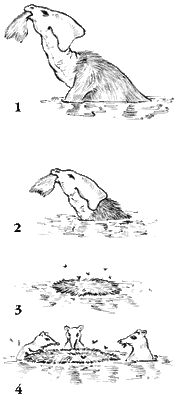
The bricket's streamlined shape is ideal for fast movement through the tangles and thickets of the temperate woodlands. The shape of the crest parts the vegetation as the animal runs, and the slim body allows it to pass between close-growing trees. The brownish colour camouflages the animal when motionless, but when it breaks cover and runs it can do so quickly, vanishing at speed into the depths of the forest.
The bricket, Rubusaurus petasus, is a mid-sized lambeosaurine hadrosaur that is very deer-like in its lifestyle, from The New Dinosaurs: An Alternative Evolution. It comes from the deciduous and mixed woodlands of Europe.
The deciduous woodlands of the Palaearctic ecozone are found mostly north of the Alps, where Eurasia narrows and few places are far from the sea. It is a region of high rainfall and temperate climate. There are four marked seasons: dormant winter; spring in which leaves and flowers appear; summer with the most vigorous growth; and autumn, which is a time of fruiting just before the trees lose their leaves for winter. The predominant trees are oaks, ashes and beech, below which is usually an understory of smaller trees and a thick undergrowth.

The long flat tail of the bricket is used both as a prop, when browsing from high branches, and as a warning flag at times of danger. Stuck straight up in the air its bright colors warn the rest of the herd of approaching predators.
A typical animal of this environment is the bricket, a small browsing hadrosaur, not dissimilar from its Cretaceous ancestors. In the Cretaceous period there were only the hadrosaurne hadrosaurs living in this corner of the continent, but later the lambeosaurines migrated here from further east (part of the great spread of the hadrosaurs over the northern continents). The bricket lives in small herds in the dense undergrowth and bramble thickets, usually resting during the day and feeding at dusk and at dawn. The expanded crest, found in both males and females, is both used as a display structure, particularly during the autumnal mating season, and as a deflecting device when it must move swiftly through the vegetation.

Ticks, fleas and other parasites are easily picked up by thicket-living vertebrates. The bricket has a cleansing ritual that deals with this. A bricket suffering badly from parasites seeks out a piece of fur or a mat of hair that has been lost by a placental mammal on the bramble thorns. Then, holding the fur in its mouth (1), it walks backwards into a river (2), very slowly, until it is totally submerged, but for its snout. The parasites move up the body, the neck and the head, and are eventually all stranded in the piece of fur. The bricket then abandons the fur and its passengers to the current (3). There usually follows a period of playful high spirits in the water as several newly cleansed brickets frolic with one another. Mating usually takes place at this time. Further downstream the fur is seized by hungry zwims that feast on the parasites (4).
